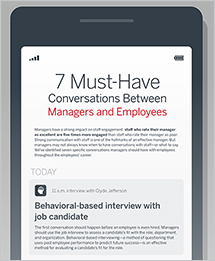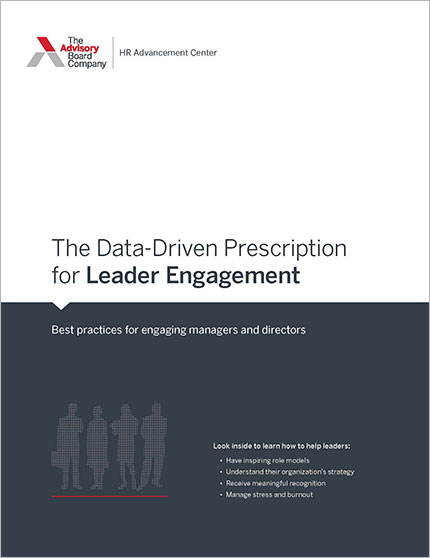
By Craig Pirner, Managing Director, Talent Development
Public speaking is stressful for many people. In fact, glossophobia—the fear of public speaking—is frequently cited as one of the most common, and intense, fears people experience.
But you shouldn't gloss over glossophobia. While an understandable fear, leaving it unaddressed can be professionally debilitating and organizationally harmful—stopping you from sharing your ideas with others (and thus spreading your influence) and preventing your organization from benefiting from the ideas you might communicate.
The faculty of Advisory Board’s Talent Development group has been speaking publicly and helping others do the same for many years. Here's some of the things we've learned about how to overcome your fears and maximize your effectiveness.
Tip #1: Aim to communicate, not perform.
Most importantly, focus on communication, not performance. If you can focus on your message—rather than making a presentation—you’ll feel less nervous, you'll present more naturally, and the audience will perceive your authenticity.
This of course, hinges on you having a message of value to the audience—and brings us to an important self-test: you won't believe yourself to be a worthy messenger unless you believe you're presenting a worthy message.
I recently worked with a person who remarked that a presentation she was about to deliver was "so boring." I replied, "If you're bored, imagine how your audience must feel. At least you have something to do." She wasn't (yet) over the hump of believing in the message and, thus, believing in herself to deliver it.
To pass this self-test, you have to spend as much—if not more—time preparing your message as you do preparing your presentation. First, decide what you want to say or teach, then make your presentation. Message first, PowerPoint second.
As you prepare your message, and yourself, consider the following:
- Analyze your audience. Have a point of view about what they need to know from you and to what extent this overlaps with what they are expecting to hear from you.
- Focus on your audience's needs more than your own. The more people analyze their audience, the better they are at speaking. It's a matter of mindshare: the more share you give to the needs of your audience, the less share you give to your own fears or inadequacies.
- Nurture and reflect upon the message you must communicate. Before you can present it, you must understand it. Through this process, you're likely to take ownership of the ideas. That ownership results in a clarity of tone and an underlying confidence that boosts your presence and reduces disfluencies.
- Own your ideas. Throughout my career, I've often been asked to help people who project a lack of self-confidence when speaking or who fall prey to annoying tics—e.g., their presentation is, um, like, literally filled with, well, disfluencies! (A professor of mine had a great term, he called this "mall speak.") I’ve discovered that, in most cases, the root cause of "mall speak" is less about the mechanics of speaking and more about the message. Many "mall speakers" have a clear mission: "Get this finished and get out of here!" That is exactly what they accomplish.
Tip #2: Eloquence isn't extemporaneous
Once you're owning the ideas, you can turn to how to present them. While there are certainly some talented extemporaneous speakers, eloquence is rarely extemporaneous. Rather, the world's best presentations are written.
Nervous speakers are almost always more nervous—or, at least, they manifest more nervousness—when they are trying to speak from an outline or (even worse) a PowerPoint slide.
Why? Mindshare. When you're having to devote mindshare in-the-moment to what words to use, how to transition between ideas, and how to illustrate your points, you're devoting less mindshare to actually communicating. You're focused on your needs ("What are the words I should say here?") more than your audience's needs.
When you have written your presentation, you've thought through all of the presentation issues in advance—and chosen the words, rhetorical devices, and evidence that are likely to resonate most powerfully with your audience. And if, in a fit of nervousness, you forget what to say, you can look down and be reassured that your planned words are right there.
As you write your presentation, consider:
- How can you appeal to various learning styles (visual, auditory, tactile)?
- To what extent are you integrating different kinds of evidence (logical, emotional, values-based)?
- Through what lens are audience members likely to listen to your presentation? How can you honor that lens?
Tip #3: Be (a polished version of) you.
If you have a written presentation, how do you avoid sounding like a robot?
Use your own voice. You don't need to use a different voice when making a speech. Rather, the most effective voice will be your own, natural voice. While it's helpful to study the style of really effective speakers, it's ineffective to try to copy them, because what's charismatic from them may sound forced from you. Instead, ask yourself what you like about other speakers and relate that to your own style.
Likewise, if people tell you you're using your "presentation voice,"—or if you would not speak to someone across the dinner table using the same style—you have to work to do on being more conversational.
Of course, you do want to be a polished version of yourself. To become polished, practice makes perfect. To focus your practice—especially when you have limited time to conduct such practice—consider the following:
- The beginning and the end are most important. If your time is limited, aim to get to the point with the first and last few minutes of your presentation where you would feel comfortable speaking even if your notes were yanked away from you.
- If you're using a visual aid, aim to get to the point where you know the next graphic without prompting. That's a good sign you really know the narrative of your presentation.
- Aim to feel like you're talking about something, versus reading something in your head.That's a sign you've internalized the presentation.
Tip #4: Variety is the spice of life.
How do you avoid sounding like Charlie Brown's teacher (a.k.a., monotone?) Through vocal variety. As you consider where to use variance to enhance your message, think through the following issues:
- Pitch. Consider how you can use the full range of your voice. For instance, a lower pitch often conveys seriousness of purpose, while a higher pitch often underscores humor.
- Volume. Aim to always be heard, but do vary your volume as you present. Decreasing volume can often be as effective in getting attention as raising volume. If you raise volume, be sure to come back down (otherwise you’ll be shouting by the end of the presentation!) Listen carefully for a tendency to trail off in volume as you speak. This is annoying to listeners, and most often, it's the result of not using your diaphragm and thus losing your breath by the end of the thought.
- Tempo. Consider carefully how quickly you are speaking. Avoid relentless use of the extremes: Speaking too quickly makes your audience tired (because they have to work extra hard to keep up with you), while speaking too slowly makes your audience bored (because they have to work hard to stay energized). In general, aim for a conversational pace, and then use hastened or slowed tempo to emphasize a point.
- Tone. This is the most nuanced of the vocal variety strategies; tone is about the emotional content of the voice. Consider the extent to which your tone matches your message. For example, if you're sharing a difficult patient story, a dispassionate tone may conflict with the emotional message. If you're sharing the latest scientific evidence, an overly emotional tone may distract the audience from the message itself.
While it is important to seek variation, it must be grounded in your message. Vary your pitch, volume, tempo, and tone because you believe it enhances what you are there to communicate. Variation for the sake of variation alone is maddening to the audience—it feels like a performance.
Tip #5: Give the audience a hand.
Gestures can be a powerful means of communicating non-verbally, but avoid the extremes. Talking with your hands proves distracting to the audience, while never using your hands can seem wooden. Instead, consider where you can gesture with a purpose. There are four categories of purposeful gestures:
- Descriptive. These gestures clarify or enhance your message.For example, holding up three fingers while saying, "There are three critical points to remember…"
- Emphatic. These gestures underscore what is being said through a forceful movement, such as pumping a fist or pointing. Politicians use these a lot!
- Suggestive. These gestures symbolize emotions or ideas. For example, you might shrug your shoulders to convey uncertainty.
- Prompting. These gestures enhance the likelihood that your audience will respond.For example, raising your hand as you ask "does anyone have a question?" will help generate raised hands in the audience.
Tip #6: Adapt to the setting.
The space in which you present—specifically, its size and layout—has implications for your presentation. Once you know the space, think through how it affects:
- Formality. Small spaces lend themselves to elements of informality (e.g., sitting at the table with the group to whom you present), while large spaces often require more formality.
- Audio-visual. Consider whether you should project your images on a screen, provide handouts, or both. Think carefully about using a microphone—if you think you might need one, you likely do.
- Movement. Think about if the space allows you to present from several different locations or forces you to stay put. If there's room to move, take advantage, but try to have that movement be purposeful. For example, if there's a section where you really want people focused intently on what's on the screen, you might consider presenting from behind the group.
- Magnitude. The best speakers adjust the magnitude of their volume, gestures, and personality to suit the space. For instance, a large space can quickly 'eat' a speaker and requires gestures that may feel unusually large from the speaker's point of view, but that read naturally in the room.
Hopefully, with these tips—and your own dedication to practice and improvement—you can enhance your speaking effectiveness and therefore feel more comfortable in front of a crowd.
Your guide to a healthier, happier workplace
Good health care delivery starts with a healthy workplace for providers. If you missed our popular webconferences on how to succeed in the workplace—or just need a refresher—don't worry; we've got you covered.
Review the slide decks from our webconferences to learn how to:
Don't miss out on the latest Advisory Board insights
Create your free account to access 1 resource, including the latest research and webinars.
Want access without creating an account?
You have 1 free members-only resource remaining this month.
1 free members-only resources remaining
1 free members-only resources remaining
You've reached your limit of free insights
Become a member to access all of Advisory Board's resources, events, and experts
Never miss out on the latest innovative health care content tailored to you.
Benefits include:
You've reached your limit of free insights
Become a member to access all of Advisory Board's resources, events, and experts
Never miss out on the latest innovative health care content tailored to you.
Benefits include:
This content is available through your Curated Research partnership with Advisory Board. Click on ‘view this resource’ to read the full piece
Email ask@advisory.com to learn more
Click on ‘Become a Member’ to learn about the benefits of a Full-Access partnership with Advisory Board
Never miss out on the latest innovative health care content tailored to you.
Benefits Include:
This is for members only. Learn more.
Click on ‘Become a Member’ to learn about the benefits of a Full-Access partnership with Advisory Board
Never miss out on the latest innovative health care content tailored to you.




